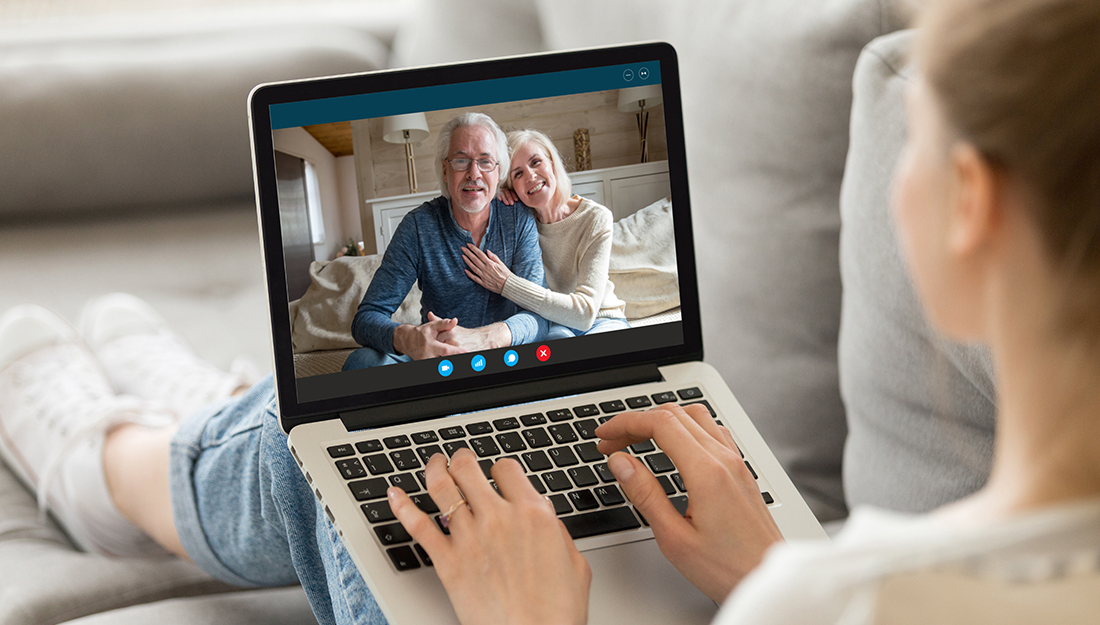- Tim Schnettler
- COVID-19, Public Health, Research, Show on VR homepage
Focusing on the positive
Finding ways to interact with family and friends is more important than ever during these trying times

Over girl shoulder pc screen view, sit on sofa living in country grandparents communicating with adult granddaughter via videocall. Parents and grownup daughter talking use videoconference app concept
We have all heard the messages about what we are not supposed to do as the United States fights to get a handle on the COVID-19 pandemic sweeping through the country. Stay home as much as possible. When in public, maintain a six-foot separation. Wash your hands often.
We are constantly bombarded with the messages of how we can help to prevent the spread of the disease and it plays on a constant loop on television and radio in an effort to drive the point home with the American public.
Although it seems all we hear are things we shouldn’t do, there are plenty of things we can do, and Angela Clendenin, PhD, MA, an instructional professor in the Department of Epidemiology & Biostatistics at the Texas A&M School of Public Health, stresses that while we must take social distancing seriously, we also must find ways to interact with family and friends.
“Psychologically it is a whole new world for people and not being able to interact, it can be very depressing and stressful,” Clendenin said. “We need to encourage compliance and also remind people to focus on what we can do. There are some really positive things happening. I have heard about people living in a cul-de-sac sharing a meal while sitting in their own driveways and talking with their neighbors. They are adhering to social distancing, but they are still having social interaction.
“There are other things that we can focus on. People can garden, go for walks, scrapbook. There is time for us to be creative and focus on the things we can do to help us not be so stressed.”
Lessons from a tale of two cities
What we are experiencing during this COVID-19 outbreak is something that has not been seen since the Spanish Flu pandemic in 1918. There are few individuals who survived that pandemic and are still alive today to experience this one.
However, according to Clendenin, there are lessons to be learned from the 1918 pandemic. One of the hardest hit cities was Philadelphia, while St. Louis, a city of similar size at the time, fared much better. The reason, says Clendenin, has to do with what is being preached to help fight COVID-19—social distancing.
During the summer of 1918 the city of Philadelphia, despite the pandemic, went forward with its plans for a World War I parade to boost morale and support the war effort. According to a Smithsonian Magazine article, an estimated 200,000 people packed into downtown Philadelphia for the event, and within 72 hours of the parade every bed in Philadelphia’s 31 hospitals was filled.
“It really was a tale of two cities. Philadelphia continued with its war parades to boost enthusiasm and when the Spanish Flu hit, they had thousands of deaths,” Clendenin said. “St. Louis didn’t continue with its parades, had significant social distancing and encouraged people not to gather, and at the end of the pandemic only had hundreds of deaths not thousands, and lower numbers of sick individuals. Historically, and overall in global history, it has been proven that it works.”
And, it has been shown to work so far with this current pandemic, as some prediction models are showing what appears to be a downward trend in the near future.
Be there for each other by staying physically apart
There is no clear indication of when the COVID-19 disaster will end.
This, according to Clendenin, is one of the things that makes this so much different than other disasters most people have experienced. Although people have become accustomed to natural disasters—floods, hurricanes and tornadoes—and they may have been forced to take shelter, they know that it won’t be for an indefinite amount of time.
“Every disaster we have faced has had a beginning and an end,” Clendenin said. “It can take weeks and months to recover, but the threat ends and we know when it will end. Right now, we don’t have that identified endpoint with COVID-19.”
And when those previous threats have ended, people didn’t have to maintain their distance from each other. They are allowed to socialize and begin to try and help each other return to a normal way of life.
“The response after a hurricane, one of the shining moments, is neighbors helping neighbors recover, helping rebuild homes and taking care of one another,” Clendenin said.
Although we may not be able pat a neighbor on the back, or physically offer a helping hand, we can still help our neighbors as we all work to get through these tough times.
“Social distancing is difficult, especially when it may be over a prolonged period of time. But by being creative in finding new things we can do, we can and will get to the other side of the curve. These next few weeks will be critical and one of the most important opportunities to be there for others and to help with stopping the spread of COVID-19. This is something we can do and, as Texans, something we should do by being compliant to these stay-at-home orders,” Clendenin said. “Just like our response to other disasters we need to do what makes us Texans and take care of one another.”
Media contact: media@tamu.edu


